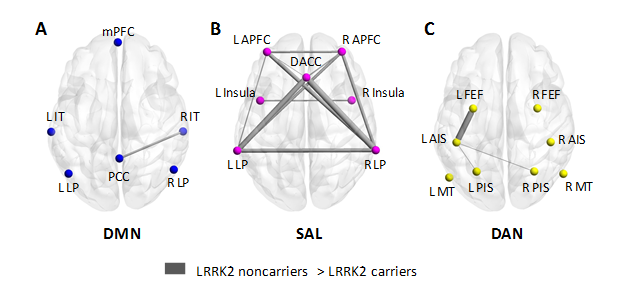Session Information
Date: Monday, October 8, 2018
Session Title: Parkinson's Disease: Genetics
Session Time: 1:15pm-2:45pm
Location: Hall 3FG
Objective: To assess the integrity of resting state networks in non-manifesting carriers of the G2019S mutation in the LRRK2 gene.
Background: Non-manifesting first degree relatives of LRRK2-PD (NMC) represent a population at an increased risk for future development of PD. fMRI studies have detected differences in activation and connectivity measures among NMC compared with non-manifesting non-carriers (NMNC) of the G2019S mutation, specifically in the motor network. Here we assessed the integrity of the default mode (DMN), salience (SN) and dorsal attention (DAN) networks using a resting state fMRI scan in this population.
Methods: Participants were screened for the G2019S mutation and underwent a comprehensive assessment comprising of clinical history, motor rating based on the Unified Parkinson’s Disease Rating Scale (UPDRS-III) and the University of Pennsylvania Smell Identification Test (UPSIT). Cognitive assessment included the Montreal Cognitive Assessment test (MoCA), and a computerized cognitive test battery (Mindstreams, NeuroTrax Corp., NY) designed to evaluate multiple cognitive domains including attention, memory, executive function and motor skills. Participants underwent a 7.5 minute resting scan. Two different connectivity measures were used to assess the integrity of the three networks: inter-regional functional connectivity analysis and Dependency network analysis (DEPNA). Machine learning classification methods were used to distinguish the connectivity between the two groups of participants.
Results: Forty-four NMC and 41 NMNC participated in this study; no between-group behavioral differences on standard questionnaires could be detected (Table 1). NMC demonstrated lower connectivity measures in all three networks compared to NMNC using both connectivity methods, with the most significant differences noted in the SN in both analyses (Figure 1). These differences were correlated with attention measures among NMC. The machine learning algorithm revealed significant classification power with overall accuracy of 84% (0.84±0.023, p<0.001).
Conclusions: We detected significant differences between NMC and NMNC in three neural networks (dorsal attention, salience and default) using two separate analytic methods. The detected differences were characterized with higher network organization and nodal influence among NMNC compared with NMC. Future studies in prodromal PD should incorporate the utilization of an automatic classification on measures of resting state fMRI scan in order to assess its validity.
To cite this abstract in AMA style:
A. Thaler, Y. Jacob, T. Gurevich, R. Helmich, B. Bloem, A. Orr-Urtreger, N. Giladi, L. Yahimovich, A. Mirelman, T. Hendler. Resting state networks abnormalities among healthy LRRK2 mutation carriers [abstract]. Mov Disord. 2018; 33 (suppl 2). https://www.mdsabstracts.org/abstract/resting-state-networks-abnormalities-among-healthy-lrrk2-mutation-carriers/. Accessed April 26, 2025.« Back to 2018 International Congress
MDS Abstracts - https://www.mdsabstracts.org/abstract/resting-state-networks-abnormalities-among-healthy-lrrk2-mutation-carriers/


